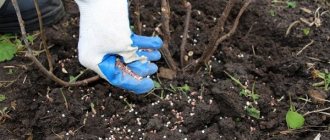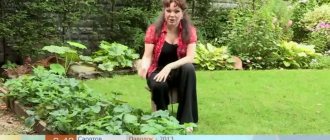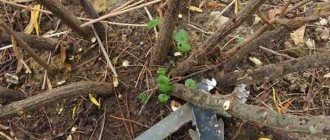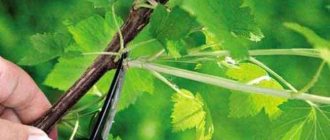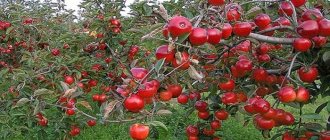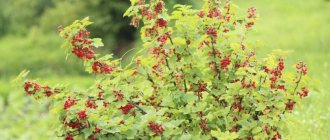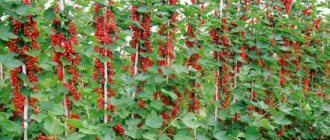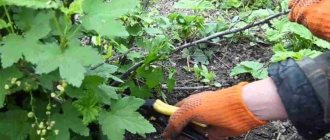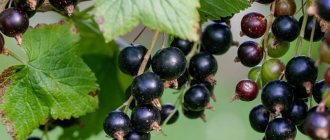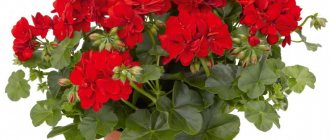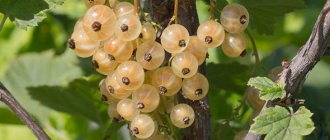1
8954
Pruning red and white currants is one of the mandatory procedures for caring for the crop. Having understood the types, timing, and stages of pruning shrubs, it will be difficult for a novice gardener to be left without a harvest. And if you add competent organization of fertilizing, then the berries will delight you with their large size and pleasant taste.
All dried and weak branches are removed
Types of pruning red currants
When caring for a red currant bush, from time to time it becomes necessary to prune branches that bear little fruit or do not bear fruit at all. It is also worth removing broken and low-growing shoots.
The yield of red currants directly depends on the degree of illumination of the bush. For this purpose, branches that block access to the main fruit-bearing shoots from the sun's rays are removed.
However, you should not cut off all the excess at once and in large quantities. In this case, the plant will spend energy not on vegetative processes, but on restoration.
In addition, intensive pruning often leads to the formation of spiny shoots - vertical shoots with weak branching. The top shoots do not bear fruit.
Before pruning red currants in the fall, you need to determine the specific purpose of the procedure being performed.
Within the framework of this criterion, 3 types of pruning are differentiated.
| Rejuvenating | The purpose of this pruning is to remove old, unproductive shoots. Red currant shoots stop bearing fruit at 6-8 years of age. |
| Formative | The procedure is needed to give the bush a neat or decorative shape, which also facilitates access to the harvest. |
| Sanitary | This pruning is not tied to a specific season. It is carried out from the beginning of spring until autumn. The point of the procedure is the timely removal of shoots infected with pests. Also, sanitary pruning after winter includes the destruction of branches damaged by frost or broken under the weight of snow. Removing thickening shoots and shoots growing inside the crown are also considered sanitary measures |
Basic Rules
General rules for anti-aging pruning of currants without replanting the plant:
- thorough loosening of the soil around the perimeter;
- First of all, damaged shoots and those growing at the bottom and on the shaded side are removed, leaving 2 cm of stump as a result of shortening;
- Undeveloped non-fruit-bearing branches aged one year and those that bear fruit poorly are subject to mandatory pruning;
- the ends of whole branches that will remain on the bush after pruning are shortened to the level of growth of powerful stepsons in order to enhance their appearance and increase productivity for the next season;
- cleaning of weeds, pruned shoots and foliage residues to avoid the preservation of pathogens of infectious diseases and larvae of harmful insects in them for the winter.
In the intervals between spring and autumn, the development of the crop is monitored, removing incorrectly growing unproductive branches, diseased and broken shoots.
Required Tools
Diseased branches are pruned first
To renew currants you will need garden tools:
- scissors;
- pruner;
- wood hacksaw.
The blades must be well sharpened so that after their contact there are sharp rather than lacerated wounds.
At the end of the work, you will need a disinfectant to treat the used tools before using them on the next shrub.
Disinfection will help prevent the possible spread of diseases and pests from diseased bushes to healthy ones. A weak solution of potassium permanganate is suitable for this.
What is the purpose of pruning, deadlines
Some gardeners forget about their fruit-bearing plants immediately after harvest. However, lack of proper care has a negative impact on the level of fruiting.
Every year the quantity and quality of berries will decrease. To avoid such a fate, you should properly care for garden plants that seem unpretentious at first glance.
Pruning is a procedure that helps obtain a bountiful harvest; its main goals are:
- rejuvenation;
- obtaining larger berries;
- improving the quality of illumination of internal shoots;
- stimulation of the vegetative function of the plant;
- removing old, diseased, broken branches that receive nutrition without bearing fruit;
- simplification of care and harvesting.
Autumn pruning begins only after the branches of the bush are completely exposed. It should be completed before the first frost. The optimal time to perform the procedure is October.
Let's watch a video on how to properly trim red currants:
How to prune red currants in autumn
The structure of the red currant bush is similar to that of black currant. However, its shoots bear fruit twice as long. In addition, the formation of red currant berries occurs at the tops of the branches.
That is why you should not shorten the tips of mature processes, even if they stand out from the overall picture. Perhaps the shoot that disturbs the beauty of the bush with its length is in the prime of fertility.
The very first pruning is carried out after the autumn planting of red currant seedlings.
While the plant is at rest, the gardener shortens the shoots by 50% to the outer bud. A year later the procedure is repeated.
In the future, ongoing sanitation procedures will be necessary.
Red currants are very sensitive to lack of lighting. Excessive thickening quickly leads to a decrease in yield. The optimal number of shoots of red currant bushes is 15-20 pieces.
Video about pruning red currants in autumn:
After 7-8 years after planting, annual anti-aging pruning is carried out. Proper rejuvenating and sanitary care of the red currant bush has a positive effect on the length of the plant’s life cycle.
On average, a carefully cared for shrub can actively bear fruit for 25-30 years.
There are several simple recommendations for pruning red currants that will be useful for beginners:
- the main task is to free the middle of the bush for its full illumination by the sun's rays;
- after pruning, there should be 4 shoots of each age left on the currant;
- to avoid damaging the kidney, the cut should be made at a distance of 5 mm from it. The pruning shears are held at an angle of 45 degrees to the shoot;
- the tops of shoots of 2 and 3 years old are not shortened;
- unproductive shoots are removed completely.
Advice from experienced gardeners
Over the years of growing black currants, a lot of experience has been accumulated in rejuvenating plantings. Perhaps every experienced gardener has his own tricks in carrying out this procedure. It is useful to listen to time-tested advice:
- If, due to age, black currants have stopped bearing fruit well, you should not try to restore its yield by increasing the amount of fertilizing and watering. In this case, you cannot do without rejuvenating the bush;
- It is better to rejuvenate an old bush in several stages over 2-3 years, so as not to injure the plant too much;
- renewal of currant bushes begins with formative pruning of a young plant: already in the next season after planting, shoots are shortened in order to awaken dormant buds and get new branches. A bush of the correct shape is much easier to further rejuvenate;
- A good way to increase yield is by pinching shoots. It is done in mid-summer on young growths and “zero” shoots;
- Before rejuvenating blackcurrant pruning, you need to get rid of diseased, broken and frozen branches.
One of the biggest problems that beginners face when starting to rejuvenate blackcurrants is determining the age of the branches. Experienced gardeners always focus on the color of the shoot: the darker it is, the older it is. One-year-old shoots are covered with delicate, smooth light gray bark; in 2-year-old shoots the bark is thicker and rougher, and several lateral branches appear. The bark of older branches is rough, cracked, and has many shoots.
Attention! If, when cutting a blackcurrant, branches with a black core or without it are found, then the plant is affected by glassworm. This pest can cause great damage to plantings, so all parts affected by it should be burned immediately.
How to rejuvenate red currants
To rejuvenate an adult shrub, you should remove the oldest branches that have begun to bear fruit weakly or have stopped altogether. Such shoots are dark in color and thick, and older shoots are often affected by lichen.
The rejuvenation procedure is usually performed for the first time in the 7-8th year after disembarkation. It should then become part of the annual redcurrant care routine.
For anti-aging pruning, the gardener will need pruning shears, garden varnish, fertilizing, and mulch.
This procedure is performed as follows:
- adult branches that have stopped bearing fruit are pruned at the root with pruning shears;
- cuts are treated with garden varnish;
- thin out the zero shoots growing in the depths;
- Fertilizers are carefully added to the soil. It is important not to damage the root system;
- the soil around is watered abundantly and mulched.
Features of the procedure
One of the goals of pruning in the fall is the appearance of new shoots that protrude above the surface from the ground and are called zero shoots.
To achieve the result, several aged but viable branches are cut out and thin vertical segments are systematically removed from the skeletal ones. For maximum and uniform fruiting, it is necessary to leave 3 zero shoots.
Pruning rules
All cuts need to be processed
- A shoot on which weak growth is observed is shortened so that no more than 5 buds remain on it.
- When determining the cut, preference is given to a place located several centimeters above the kidney.
- It is not recommended to leave large stumps due to the fact that pests can later hide in them.
- To ensure uniformity of harvest, branches of different age categories are preserved on the plant.
- The growth of new shoots is regulated - an almost identical number of them should appear every year.
- Cut strictly at an angle of 45-50 degrees.
- The number of segments left depends on the development of the culture. On powerful ones it is allowed to save up to 10-14, on weaker ones - about 5.
- The cut must be disinfected. For this purpose, special purchased preparations, garden pitch or ash can be used.
During the correction, the following is removed:
- damaged and weakened shoots;
- branches directed deep into the crown, as well as creeping along the surface of the ground;
- non-yielding segments.
Recommendations
If it is not possible to determine the age of the shoots, it is allowed to carry out a haircut according to a simplified scheme. To do this, the bush is shortened annually by ¼ of the total volume of the above-ground part. This approach greatly simplifies agricultural work for beginning gardeners.
To rejuvenate old specimens, one cannot do without radical pruning, which consists of cutting off all the branches at the root. When carrying out the procedure in the fall, the soil surface is mulched with dry straw or wood shavings.
As a result, the growth of young shoots from root buds is activated.
If the goal has not been achieved, there is no need to repeat the procedure. This is due to an imbalance between the crown and root system.
To preserve the culture, it is allowed to resort to the vegetative method of propagation.
- In May/April, one-year-old shoots are selected from the lower part of the mother bush, which are bent and buried with earth, not forgetting to moisten abundantly throughout the summer.
- In the spring, young shoots are transplanted to a new place.
Michurinsky method
This correction method allows you to rejuvenate a large amount of currants. Its principle is as follows:
- During the first 5 years of the crop’s life, exclusively sanitary and formative pruning is carried out, and only ½ of the bushes are cut off in the 6th year. Additional feeding.
- In the coming season, young plants are sorted, choosing the strongest and most viable ones, and the rest are uprooted. New cuttings are transported to the vacant space.
- Duplicate the actions with the second part of the adult bushes.
Stamb
In Western Europe, the standard form of cultivation is more popular. This concept implies the formation of a bush on a single high trunk 20-25 cm high. The advantage of this form is that the berries are located quite high and do not get dirty on the ground. In addition, standard bushes look very elegant and unusual.
To grow a bush in European style, you should address this issue immediately after planting:
- It is necessary to completely cut off all processes except the central one. The remaining shoot (trunk) is cut in half to the side of the outer bud;
- the next year, all the buds are removed to the height of the trunk. To form the skeleton of the shrub, 4 multidirectional shoots are left. These branches are shortened by half to the outer bud;
- in the 3rd year, the trunk is cleared again, and the root shoots are also cut to zero. The most viable shoots of the 2nd order are left, shortening them by 50%;
- then you need to annually remove broken, damaged, pest-infested branches. During the period of setting berries, for better fruiting, unproductive shoots are shortened by 8-10 cm.
Not all varieties of currants allow high-quality implementation of the standard form. The most suitable for this are the Firstborn and the Dutch Red.
It should also be noted that shrubs that grow on a trunk have a shorter life cycle.
Subsequent bush care
Rejuvenating pruning of fruit bushes should be done so that they have time to prepare and recover from stress before the onset of cold weather.
You can help them with this by carrying out a number of agrotechnical measures.
- Loosening the soil surface in the space around the trunk.
- Fertilizing with mineral and organic fertilizers; it is optimal to use double superphosphate, rotted manure and potassium chloride.
- Mulching the substrate with sawdust. The recommended layer thickness is 10 cm.
- Preventive treatment against diseases of fungal origin with colloidal sulfur and against pests - karbofos.
Trellis
The trellis-like shape of the currant bush looks very elegant. In addition to decorative functions, such planting greatly facilitates the process of fertilizing and collecting berries.
This form also opens the plant well to sunlight and insects that perform pollination functions.
The formation of a bush on a trellis goes through the following stages:
- selection of seedlings with 3 well-developed shoots;
- the central shoot will act as a support, 2 lateral shoots are placed opposite each other at a height of about 30 cm from the soil;
- the formation of subsequent tiers as the shoots grow and the removal of excess branches;
- After the final formation of the trellis, the central shoot is cut annually to the lower bud. The lateral processes are shortened by 2-3 cm.

